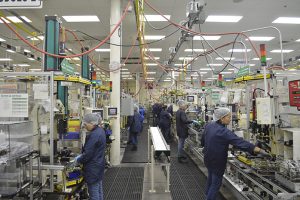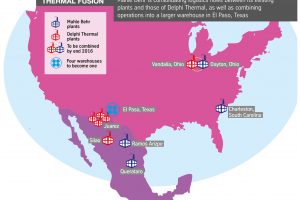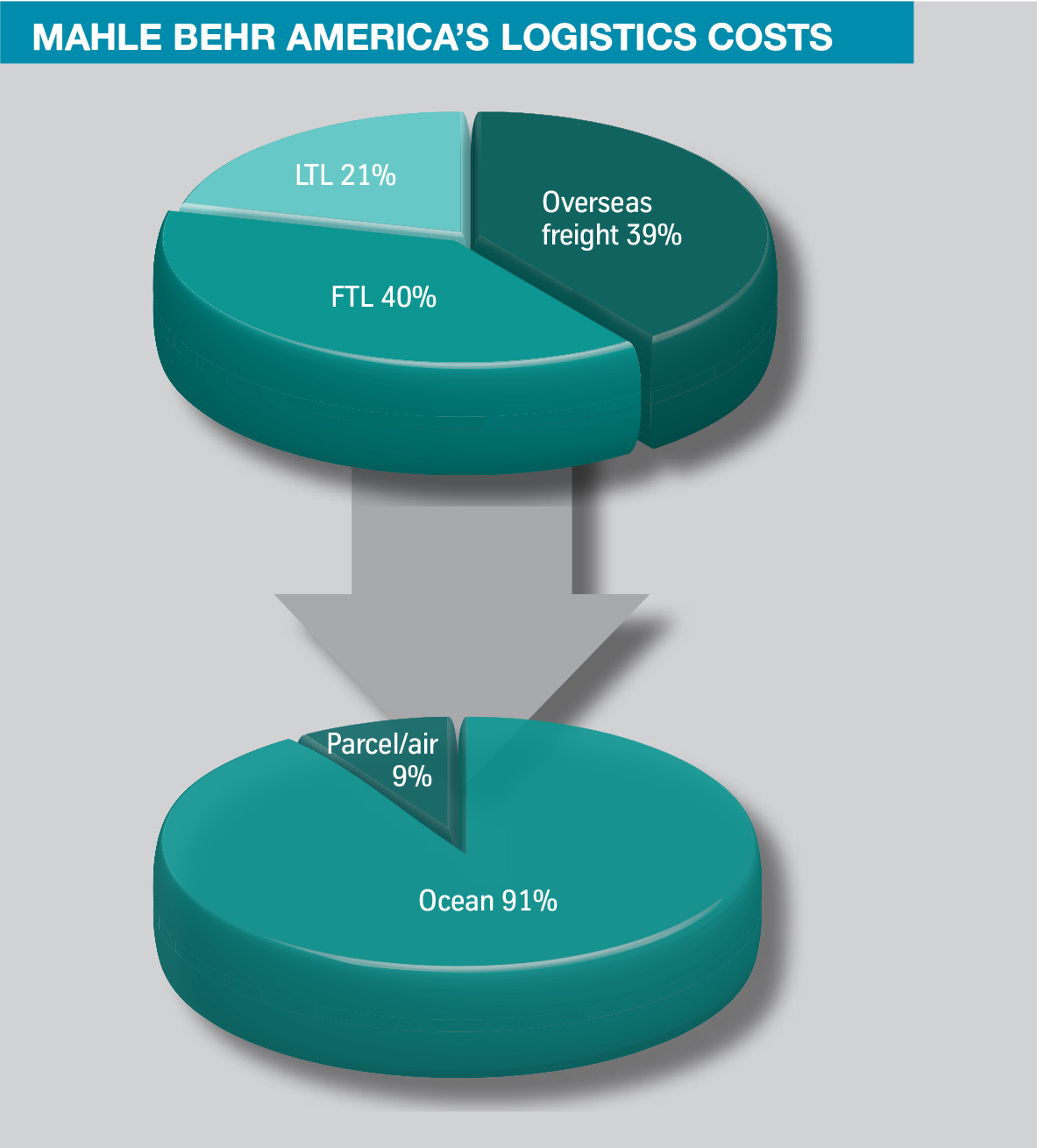Mahle Behr’s takeover of Delphi Thermal Systems in 2015 sparked a process of systems integration, freight consolidation and supply chain redesign that is set to last a further three years.
 Last year was a record one for global acquisition and mergers within the automotive supply chain. Consulting firm PwC estimated the year’s deals to be worth around $48 billion compared to $14 billion in 2014. Among the notable purchases were ZF’s $12 billion acquisition of TRW, Grupo Antolin’s purchase of Magna’s interior business and Yangfeng’s takeover of Johnson Controls’ interiors unit.
Last year was a record one for global acquisition and mergers within the automotive supply chain. Consulting firm PwC estimated the year’s deals to be worth around $48 billion compared to $14 billion in 2014. Among the notable purchases were ZF’s $12 billion acquisition of TRW, Grupo Antolin’s purchase of Magna’s interior business and Yangfeng’s takeover of Johnson Controls’ interiors unit.
A manufacturer of engine, filtration, electronics and thermal systems, the Mahle Group, based in Stuttgart, Germany, was another major buyer. Last summer it took over Japanese mechatronics specialist Kokusan Denki, as well as Delphi Thermal Systems, the global thermal systems division of Delphi Automotive. The Delphi purchase included 13 plants in Europe, North and South America, China and India, and is being integrated into Mahle’s existing thermal division (which was itself created through acquisition of the Behr Group in 2013). Delphi Thermal had important production sites in the US and especially Mexico, which are being combined in the region with the Mahle Behr division.
Such mergers present opportunities to redesign supply chain networks according to greater economies of scale, including the consolidation of freight flows and of IT systems; in North America, Mahle is wasting little time in joining together its logistics operations with Delphi Thermal. Among the early moves has been a strong investment in the customs department between the companies to improve cross-border flows between the US and Mexico. However, full integration will take several years.
Following the Behr acquisition in 2013, this latest takeover is the second major integration that the logistics team at Mahle Behr has overseen recently in North America. According to Martin Weiss, corporate logistics manager at Mahle Behr America, this merger has provided many insights into combining different and sometimes disparate supply chains. Among the lessons learned was the importance of bringing together logistics processes and systems as quickly as possible to avoid redundant processes and parallel systems.
“We also learned a lot about Mexican customs complexity within the maquiladora systems,” says Weiss, referring to the border suppliers who process material for re-export to the US. “Moreover, the merger has led to an increase in our market strength, supply and manufacturing footprint.”
Phasing in the supply chain The path towards logistics integration of Mahle Behr and Delphi Thermal consists of three phases, some of them running simultaneously. Phase I was known as ‘stabilisation’, which involved joining both companies together in areas such as customs and export licences, freight contracts, material supplies, as well as employee position changes. “Here, we addressed all operational issues and ensured a continuous supply during the change in ownership. It lasted six to eight months and was in place by the end of 2015,” says Weiss.
Phase II, which has run from July 2015 and is expected to last until June 2016, focuses on benchmarking processes and identifying best practices in areas such as border-crossing processes, packaging concepts and freight management, among others. It also involves establishing an implementation plan for carriers and suppliers, team integration, and ensuring common target settings.
 "[We] learned a lot about Mexican customs complexity within the maquiladora systems. Moreover, the merger has led to an increase in our market strength, supply and manufacturing footprint." - Martin Weiss, Mahle Behr America
"[We] learned a lot about Mexican customs complexity within the maquiladora systems. Moreover, the merger has led to an increase in our market strength, supply and manufacturing footprint." - Martin Weiss, Mahle Behr America
Phase III, which began in December 2015, is the implementation and realisation of cost savings and process improvement. For example, it includes physically changing the packaging from Delphi Thermal to Mahle Behr models, and using returnable packaging as much as possible. It is expected to last for three years.
At the heart of this multi-faceted strategy is a goal to increase freight consolidation and standards across an expanded supply chain. However, the process is a complex one, not least because of plants spread far apart. Both Mahle Behr and Delphi Thermal currently use different logistics companies, and run on different versions of an enterprise resource planning (ERP) system, which makes communication and visibility of production and inventory between them difficult.
In response, Weiss and his team plan to issue a common freight tender for NAFTA in the second or third quarter for all combined plants. They will also solicit an international freight quote in the second half of 2016 with the intention of improving total shipping and inland costs for delivery of products to export countries. Finally, Mahle Behr will harmonise the companies’ IT systems, which Weiss expects to complete by 2017. As it prepares to bring these systems together, Mahle Behr is reviewing guidelines in areas such as packaging definitions and best practices for goods inspection.
Reshaping supply networks The Delphi Thermal acquisition is changing the shape of Mahle Behr’s production and warehouse footprint in North America. The main focal point is in many ways Mexico, where most Delphi Thermal plants are located and where both companies have growing supply bases.

Originally, Mahle Behr had plants in Charleston, South Carolina; Dayton, Ohio; and in Ramos Arizpe and Queretaro, Mexico. Delphi Thermal adds five plants in Mexico, with four in Ciudad Juarez, close to the border at El Paso, Texas, and another in Silao, in central Mexico. In the US, Mahle Behr is in the process of absorbing Delphi Thermal’s Vandalia, Ohio plant into its own nearby facility in Dayton, which will be complete by the end of the year.
Outbound, the acquisition has also diversified Mahle Behr’s OEM customers, adding Toyota, and increasing deliveries to Honda, GM and Ford plants.
Along with this enlarged production and distribution network, Mahle Behr has been changing its warehouse footprint. It has a sequencing centre in Spartanburg, South Carolina that serves BMW and it recently added another in Fairfax, Kansas that serves General Motors. Last year it opened a warehouse in the Charleston Free Trade Zone (FTZ), which has helped to reduce the cost of overseas imports. An FTZ is already in place in Dayton.
The company is also consolidating its warehouse presence in El Paso from four facilities into one. Until recently, Mahle Behr used a dedicated warehouse for crossdocking, and another for storage and free carrier on-board (FCA) shipping to US customers; it also used a warehouse operated by Panalpina and another by Con-way Freight (recently acquired by XPO Logistics). These four operations are to be combined into one new, Mahle Behr-leased warehouse in El Paso. The facility will also offer vendor managed inventory (VMI), supplier consignment, short-term storage, repacking and FCA shipping. In March, Mahle Behr announced that it had selected third party logistics provider Syncreon International Group to operate the warehouse.
“Our strategy is to eliminate the use of supplier warehouses and ship directly from origin to the Mahle Behr plant or to the respective Mahle Behr-owned warehouse. We plan to have this in place by April 30th [this year],” says Weiss.
Increasing consolidation The Delphi Thermal acquisition also contributes to Mahle Behr’s highly global supply chain for its North American plants. By value, about half the material is sourced from the US, with 20-25% from Mexico, 10% from Europe – mainly Germany, the Czech Republic, France and Denmark – and 10-15% from China and India.
Most material from Europe is imported via the ports of Norfolk, Virginia and Charleston, while from Asia they arrive via the ports of Seattle, Washington and Long Beach, California. Overseas material destined for Mahle Behr plants in Mexico may move directly to Mexican ports, or it is imported via the port of Charleston and held in bonded warehouses before onward movement to Mexico. Material between the US and Mexico usually moves by truck through the El Paso or Laredo border crossings.
Though overseas material accounts for about 20-25% of the value of Mahle Behr inbound material, it represents around 39% of total logistics costs; that compares to the 40% of costs attributed to full truckloads (FTL) and milkruns within North America, and the 21% of less-than-truckload (LTL) shipments. Of the overseas materials logistics bill, 91% is ocean freight and 9% is between parcel and air freight.
Mahle Behr uses consignment tools to maximise both ocean containers and domestic truckloads. “For example, we combine two suppliers in China and ship every other week,” says Weiss. “There, we store goods in consignment; they do not change ownership until they leave the warehouse. In the US and Mexico, we are holding about $15m-20m of supplies in consignment.”
Like other manufacturers, Mahle Behr’s inbound shipping frequencies within North America vary according to volume and location. Local suppliers, which are those located fewer than 500 miles (800km) from Mahle plants or warehouses, dispatch parts daily to Mahle Behr locations by FTL. Mid-distance suppliers, which are those more than 500 miles away but within North America, move parts multiple times per week by FTL or milkruns.
Weiss is targeting the greater scale in the network following the acquisition, including a reduction in LTL freight. “Our vision is to reduce the use of LTL freight to below 15% within the next two years through freight network consolidation and shared truck runs,” says Weiss.
As Mahle Behr reorganises its logistics network, it has also made changes following the drop in fuel prices, which enabled it to switch from rail to truck without a cost penalty while also reducing transit time. It had previously used rail to transport production material from the port of Norfolk to its plants.
 Click to enlarge
Click to enlargeCommon systems and packaging To bring together Mahle Behr and Delphi Thermal networks as much as possible, Weiss and his team still have a number of major tasks ahead of them. Moving to a common IT system will be among the most complex projects. Though both companies have SAP as their ERP systems, each has a different version, which limits visibility across activities. The final step of system integration of SAP into a single system will occur in 2017; this will commonise part numbers, supplier information and logic storage locations, among other things.
“Although Mahle Behr and Delphi Thermal do not exchange many subcomponents yet, we will in the future, so transparency is essential,” says Weiss.
[related_topics align="right" border="yes"]
Mahle Behr is also considering a number of combined improvements across its external tracking systems, including risk management and vessel tracking. “We are looking at several risk management trials in order to provide early notice of interruptions,” says Weiss. “For example, for sea freight tracking, we are looking for more information on what a 3PL would provide for critical shipments.
“On the outbound side, we are incorporating sequencing requirements from customers with improvements to shipping and production modules. SAP will become more and more common.”
"On the inbound side, our recent saving for one part number was $1.4m over the project’s lifetime. We have achieved 50% higher pack density. For all parts of similar size, we have achieved savings ranging from15-50%." - Martin Weiss, Mahle Behr America
Packaging, including increasing returnables and using more intelligent pooling concepts, has been a major focus. The company has increased its use of returnable containers, including for longer distances, with a view to expanding some packaging for overseas shipments. It recently started working with packaging provider Goodpack for flows with India, along with Chep for national packaging management in the US.
“We began this focus in our Dayton plant in 2014. The trend is for long-distance returnable containers. We should be starting with Chep by March [this year] with several long-distance suppliers, and eventually from overseas,” says Weiss.
However, Mahle Behr will have to complete guidelines for common containerisation before such a system will work across a combined packaging pool.
Weiss also points to efforts to increase packaging density. “On the inbound side, our recent saving for one part number was $1.4m over the project’s lifetime. We have achieved 50% higher pack density. For all parts of similar size, we have achieved savings ranging from 15-50%,” he says.
These changes have reduced Mahle Behr’s transit time and its in-transit inventory from Mexico to Dayton. They have also avoided costs while improving floor space usage through increased packaging density. “We have reduced our inventory costs by $750,000,” notes Weiss.
 Mahle Behr is changing its warehouse footprint to better suit its more diverse and larger production and distribution network
Mahle Behr is changing its warehouse footprint to better suit its more diverse and larger production and distribution networkA better future, together As Mahle Behr already found out three years ago during the integration of Behr, merging and realising synergies in logistics is easier said than done. Complex, historic systems need to be combined for transparency and efficiency, such as packaging tracking, but they involve changes across organisations and processes. New and expanded flows must be absorbed as quickly as possible into the common network, but this can also involve difficult changes to consolidation locations and logistics providers.
The company is nevertheless seeing success so far, including in re-engineering consolidation and packaging. Exchanges in staff between Mahle and Delphi Thermal have helped to speed integration, as have specialised management teams. For example, the company established a continuous improvement planning team to drive improvements and implementation across the NAFTA region, as well as one specifically for new emerging supply countries.
As scale and standardisation become more important in the tier supply chain, the Delphi Thermal acquisition has expanded Mahle’s scope for economies of scale and new customers. The merger has also afforded the company an opportunity to benefit from greater logistics cohesion through system integration and freight consolidation. There is still some way to go, but the combined company should emerge with a far more agile, competitive supply chain.


























![Global[1]](https://d3n5uof8vony13.cloudfront.net/Pictures/web/a/d/s/global1_726550.svgz)









